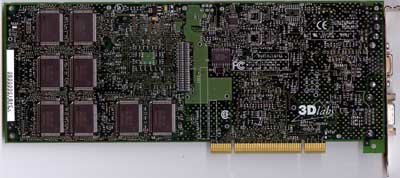Enter the GVX1
3Dlabs is one such contributor to this sort of competition as they have always strived to bring the power and performance of the most powerful graphics accelerators down to a desktop workstation level without the high price tag. Their Oxygen line of video cards is intended to tailor to this very market, especially the GVX1, which was released earlier this year.
The Oxygen GVX1 offered a sub $1000 graphics solution that was providing some serious competition to alternatives priced in the $1000+ range, but one of the true benefits of its architecture has been left hidden until very recently. As we're all familiar with, the current AGP implementation on all x86 chipsets that support it only allow for a single AGP slot. While this isn't a problem for most gamers and other enthusiasts, for professionals that want to run their professional 3D applications across multiple monitors without sacrificing performance, they are left in an interesting situation.
From the point of view of the manufacturers, they have a few options in this scenario. One is to include multiple VGA outputs on their boards (à la G400 DualHead), but this method splits the performance of the single chip evenly between the multiple outputs and thus the overall performance decreases. A second option is to include multiple chips on a single board. While this delivers the same performance to each monitor as having a single card for each monitor would, it is a binding purchase since there is no upgrade path, meaning that, if somewhere down the line you decide you need to add a third monitor to your setup, your current dual output board won't cut it. The third and final option is to provide support for PCI versions of your card and, through drivers, make sure that the performance remains constant between all displays.
This final option was the route taken by 3Dlabs as they introduced the long awaited PCI version of their Oxygen GVX1 which allows support for a number of flexible multi-head output configurations of up to 8 boards. How does this relate to the issue of increasingly powerful consumer level cards that we discussed before? With the advent of NVIDIA's GeForce 256, the professional graphics industry has been shaken by a sub $300 card that is capable of delivering floating point performance of approximately 50 billion operations per second. This is in contrast to the 3 billion floating point operations per second the 3Dlabs Oxygen GVX1 is capable of. However, what we're about to find out is that numbers don't mean everything in the professional graphics market and in spite of the GeForce's arrival, the GVX1 offers itself as a cost effective solution that delivers the performance and quality that we would expect from any card that is priced in the $1000 range.












3 Comments
View All Comments
evilpaul666 - Wednesday, October 14, 2020 - link
First!Railgun - Thursday, October 15, 2020 - link
Welp, if we’re going to be children...First is worst. Second’s best.
domboy - Thursday, October 15, 2020 - link
Reading this all these years later I realize several things. I miss- single slot cards
- having more than just two gpu vendors
- video cards with green PCBs
Good old PCI bus. I don't miss AGP though... glad PCIe came along to to allow one standard for all add-on cards.